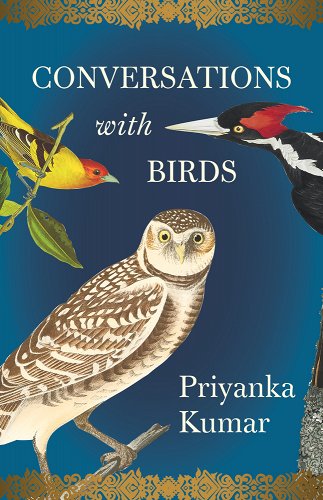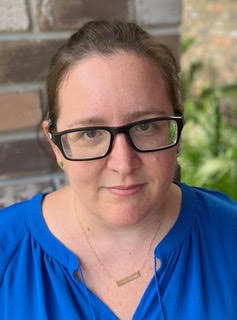Reviewed by Emily Webber
 Priyanka Kumar’s Conversations with Birds (Milkweed Editions, November 2022) lovingly details the rich diversity and wonder-filled world of birds and other wildlife and shows us how a life connected with the natural world can lead to inner peace and well-being. Kumar infuses her nature writing with personal memoir, her Indian culture, and how it forms her outlook on life. While focused on her personal experiences, Kumar’s essays come at a time when we really need every kind of nature writing in the hopes that these stories will spark others to become more aware of the world around them and enact change to protect it.
Priyanka Kumar’s Conversations with Birds (Milkweed Editions, November 2022) lovingly details the rich diversity and wonder-filled world of birds and other wildlife and shows us how a life connected with the natural world can lead to inner peace and well-being. Kumar infuses her nature writing with personal memoir, her Indian culture, and how it forms her outlook on life. While focused on her personal experiences, Kumar’s essays come at a time when we really need every kind of nature writing in the hopes that these stories will spark others to become more aware of the world around them and enact change to protect it.
As a small child, Kumar lived in northern India, where she spent much of her time in nature. Then, as a teenager, her family moved to the United States, and she felt increasingly disconnected from the natural world. Later, as an adult working in the film industry, and as a woman coming from a different culture, she didn’t always feel like she fit in. Birding brings back that connection for her. She takes the reader on her birding journey, whether it be observing the curlews that bring her back into birding or her multiple trips to observe bald eagles. She shows us how, as she writes in the book’s preface: “Birds are my almanac: they tune me into the seasons, and to myself.” She shows how a single bird can serve as a point of entry to the natural world for someone and how being connected to the natural world can lead to a better connection with oneself and the community.
Kumar’s essays, paired with beautiful black-and-white illustrations of birds, are lively and educational. Each piece in Conversations with Birds gives the reader all the information—the scientific names of birds, their preferred habitat, mating and nesting rituals, and the details of each unique personality of the birds. Kumar, who is both a filmmaker and writer, knows how to engage her audience.
Morning brought not the woodpeckers’ drumming but the scolding calls of the Steller’s jays, Cyanocitta stelleri, and the tinny tooting of distant red-breasted nuthatches, Sitta canadensis. The eager toot of this little nuthatch is a joy to hear. Often one nuthatch is joined by another, then a few more, spurring a musical conversation.
I am a bird lover. Outside my office window, I’ve set up an area meant to attract birds and watching these small things with wings brings me immeasurable joy and hope. I may be a little biased going into Kumar’s book, but even if you aren’t yet taken with birds, Kumar’s writing will likely win you over, and you’ll find yourself starting to scan the sky. She perfectly describes the effect that watching birds can have on someone:
In birding, there is a forgetting, a coming out of oneself, while paradoxically also a going deeper into oneself. Standing in a leafy canyon, waiting in green silence for a bird to appear, my mind hushes to a whisper.
The beauty of this book is its balance. There’s not too much of anything. There’s a perfect balance between the writing on birds and other wildlife, her life experiences, and the larger cultural and ecological history, that makes this book work so well. Kumar’s writing is infused with spirituality and culture. Along with all her birding journeys are reflections on how we fit into the world, grieve lost loved ones while looking toward the future, raising children, and the meaning of a well-lived life.
A non-birding thread that carries through the book are the unexpected and early deaths of her brother and father a little over a year apart. Later her mother dies unexpectedly before the birth of Kumar’s first child. She talks about our ineffective mourning of loved ones, her yearning to introduce her children to her parents, and how she eventually realizes that her family members lived a full life in the community with others. It brings to light how much birding mirrors lif with disappointments, waiting, and periods of stagnation. There is heartbreak and danger, but there are small and grand moments of beauty and wonder that outweigh all the rest. She describes the aftermath of an expedition made harrowing by inclement weather:
When the safe boundaries that we take for granted in everyday life disappear, we are exposed to startling risks but the experience can also crack the heart open. It strips away what is unnecessary. That is how I still feel after yesterday’s expedition: raw and ajar. At any moment, while absorbed in transient joy or sorrow, we are only dimly aware that we stand on a precipitous mound. The road ahead plunges down—we can’t see the end point, yet it patiently and inexorably awaits us.
There are few mentions of television, Ipads, cell phones, or social media, and it is glorious to be in this world with Kumar. It will prompt you to get out and explore wherever you are living. She purposely takes her children on her adventures even if it isn’t always comfortable or easy, hoping that someday these adventures will spark care for the land and a desire to protect it and its wildlife.
Kumar’s writing made me reflect on how hard it is to be a bird in the world today. The birds here constantly battle traffic, well-meaning people feeding them harmful food, pesticides, and manicured lawns that remove native plants and nesting places. Kumar continually calls out how we are destroying wildlife habitats and the present and future implications. In Conversations with Birds, Priyanka Kumar inspires one easy solution through her example: get out and explore. Observing the wildlife and connecting with the natural world will make you more apt to find ways to protect it.
 Emily Webber’s writing has appeared in The Writer magazine, the Ploughshares Blog, Five Points, Maudlin House, Brevity, and Slip Lip Magazine. She’s the author of a chapbook of flash fiction, Macerated, from Paper Nautilus Press. Find more at emilyannwebber.com and on Twitter: @emilyannwebber.
Emily Webber’s writing has appeared in The Writer magazine, the Ploughshares Blog, Five Points, Maudlin House, Brevity, and Slip Lip Magazine. She’s the author of a chapbook of flash fiction, Macerated, from Paper Nautilus Press. Find more at emilyannwebber.com and on Twitter: @emilyannwebber.


